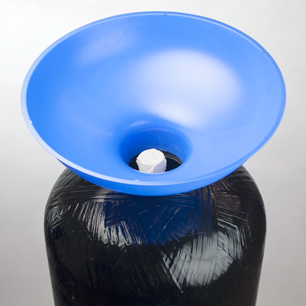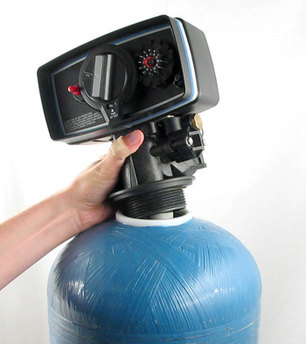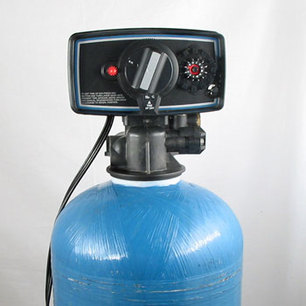Installing Backwashing Filters
Large backwashing filters are simple devices. They consist of a tank filled with a filter medium, a tube called a riser inserted into the tank, and a control valve to manage the flow of water through the filter.
Pure Water Products' residential filters use the Fleck 5600 SXT control valve—a simple, time-proven tough performer that will give many years of trouble-free service under normal conditions. It's easy to install and program, and easy to repair if a problem comes up.
Most backwashing filters for treating sediment, iron, or chlorine and other chemicals differ only in the filter media they hold. These instructions apply to all filters containing standard filter media such as carbon, zeolite, calcite, Katalox Light or Filox-R.
Pure Water Products 5600 backwashing filters feature a premium Vortech mineral tank that does not require a gravel underbed.
Be sure you have the whole filter before you start.
You should have:
-
A Vortech mineral tank. Vortech mineral tanks include a pre-installed riser tube. The riser is locked into the bottom off the tank and should not be removed. Riser should be approximately flush with the opening of the tank.
-
A Fleck 5600 SXT Control Valve. The valve will be pre-programmed and have a drain line flow control (DLFC) pre-installed. A label attached to the valve near the drain connection will be marked, in gallons per minute, the size of the flow control button installed in your unit. Flow controls for most filters in this category are 5.0 or 7.0 gallons-per-minute. (This is what determines how much water per minute is used during backwash. It's an essential part, so contact us if you're in doubt that the flow control was installed.)
-
Filter media. The amount of media will vary depending on the size of your specific system. Check your included documentation for the media amount. All of the media should be loaded into the tank during installation unless noted otherwise.
-
A media funnel to load the filter medium, and a 25' roll of 1/2" drain tubing and a ring clamp to secure the drain tubing.
-
A 1" or 3/4" bypass valve to connect the control valve to your plumbing.
Loading and Installing the Filter
For city installations, install the filter at a point of entry so that all water that you wish to filter will pass through it. For wells, the preferred installation spot is in the main water line after the pressure tank. Filters almost always go before softeners and ultraviolet systems. Please call us if you're in doubt.
The unit must have access to a drain, so keep that in mind when choosing an installation spot. The shorter and more direct the run to the drain, the better.
When selecting a place for the filter, keep in mind that you're eventually going to have to change the filter medium. Put it in a place where it will be easy to service. The tank is light now, but it won't be when it's full of water.
Here's how you load the filter:

-
Cover the top of the riser tube with tape, a plastic bag, or fashion a plug so that media won't be poured into the center of the tube. Allowing media to enter the riser tube will cause media to be passed into the service line during startup and can cause damage to downstream plumbing and appliances.
-
Next, using the funnel provided, pour the filter media into the tank. Having a helper hold the funnel and guide the media into the tank as you pour is helpful. Pour in all the media supplied with the system. It will not fill the tank completely. The unfilled tank space above the media bed, called “freeboard”, is essential for proper backwashing of the media.
Avoid breathing the dust that comes off the media as you fill the tank. Filling the tank in a well ventilated area with a face mask is recommended.
Installing the Filter Valve

-
5600 filters have two O-rings. One is inside the center hole in the bottom of the valve. It makes a seal when the riser tube is inserted past it. The other O-ring fits in a lip located just above the threads that screw into the tank. If the two O-rings on the valve are not lubricated, put a small amount of plumber's silicone lubricant on each.
-
Screw the filter valve onto the tank. (Don't forget to remove the temporary plug from the end of the riser tube.) The tube slips into the center hole at the bottom of the valve. No tools are needed, just hand tighten the valve until it's snug. Do not over tighten.
-

When the valve is installed, set the filter in place and install it to your home's plumbing according to your local plumbing code. “In” and “Out” flow directions are indicated on the side of the valve body and on the bypass valve. Be sure you get it right before connecting the filter to your plumbing.
-
Attach a drain hose to the barbed drain fitting that comes out of the back of the control valve. Secure it with a hose clamp. Attach to a drain according to local plumbing code, or if convenient, place the end of the drain line so that it can drain onto the ground. Keep in mind that during the backwash cycle the filter will run many gallons of water out the drain line. Drain lines can be plumbed directly with PEX or PVC piping if desired. Remove the installed 1/2" barb fitting and install the appropriate 1/2" MNTP fitting into the valve body. Do not over tighten drain fitting.
When the bypass valve is clamped onto the valve, it may feel loose. This is not a problem, the looseness is engineered into the system to provide the installer some “wiggle room”. If your incoming pipe is a little too high or low, the bypass valve or yoke will move up or down to accommodate.
Start-Up
Refer to included startup and rinse instructions for full startup procedure.
System operation and maintenance
After completing the start up and rinse procedure the installation is complete. Leave the bypass valve in "service" position and use your water normally. No day to day maintenance is required. We recommend checking the filter to confirm it is backwashing at the programmed interval.
As the system is used the media will eventually be expended and require replacement. Media lifespan will vary depending on the media type, application, usage and water quality conditions. Please contact us for recommendations for media replacement.
Control valve programming
Control valves are pre-programmed prior to shipping. Refer to the included customer setup sheet for your valve's preset programming.
Your valve is programmed for the media installed and your application. In most cases this will be correct but for some well water applications with heavy iron or H2S you may need to adjust the valve programming for your water conditions. Refer to the included SXT programming manual for programing instructions. For many applications there is no right answer for backwash interval or duration settings and trial and error adjustment is required. Please contact us for advice and recommendations on backwash programming.
Site Index
Filtration Systems
- Aeration for Iron & Sulfide
- Backwashing Filters
(whole house & well units)
- Chlorine & Chemical Injectors
- Countertop Water Filters
- Garden Hose Filters
- Reverse Osmosis, Residential
- Reverse Osmosis, Commercial
- Shower Filters
- Specialty Filters
- Ultraviolet Systems
- Undersink Filters
- Water Softeners
- Whole House Filters
Cartridges
Parts
- Replacement Parts
- Faucets
- Filter Media
- Fittings
- Housings
- O-rings
- Pumps
- Pura UV
- R.O. Parts
- R.O. Tanks
- R.O. Booster Pump
- VIQUA UV